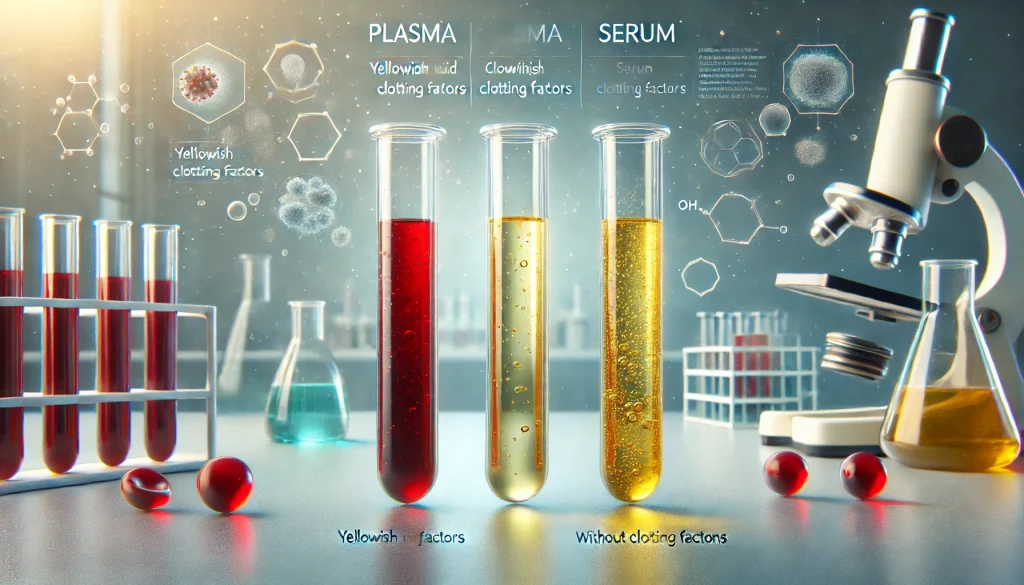Plasma vs Serum Blood A Primer on the Different Components: In medical diagnostics, it’s important to differentiate between plasma and serum blood, as the differences are crucial for accurate test results and treatments. Plasma and serum are both components of blood, but they have different properties that influence their applications. The study of plasma and serum continues to evolve with new research and technological innovations through the year 2025.
Pure Plasma and Serum Blood
Plasma and serum are liquid components of blood, with differing compositions, collection methods, and uses. Here’s a quick overview:
Plasma Blood
Plasma-based blood without the blood cells when separated. It comprises around 55% of the total blood volume and is yellowish due to the proteins it contains, little albumin, fibrinogen, and immunoglobulins. Blood plasma is critical for maintaining blood pressure, transporting nutrients, and participating in immune response.
Serum Blood
Serum is similar to plasma but has had all its clotting factors removed. It is the remaining fluid after allowing blood to coagulate and the coagulum to be taken away. The serum is light yellow and is rich in antibodies, hormones, and enzymes. Commonly used in diagnostic testing across a variety of medical diseases.
Plasma vs Serum Blood — All Differences Explained
Demystifying Plasma vs. Serum Blood: Clinical and Research Applications
Here are the main differences:
Clotting Factors
- Plasma: Includes clotting factors, including fibrinogen, that are essential for blood clotting
- Serum: Doesn’t have clotting factors, they are used during the forming of clots (→ blood clotting).
Collection Process
- Plasma: Blood with anticoagulants (heparin, EDTA) are added and clotting is prevented.
- Serum: Obtained after allowing blood to clot and spinning it down.
Applications in Diagnostics
- Plasma: For tests needing blood clotting factors, like clotting time or plasma protein levels.
- Serum: This is used to tests to measure antibodies, hormones, and other proteins that are in blood but aren’t involved in clotting.
Appearance
- Plasma: Clear and yellowish, to carry clotting proteins
- Serum: Also yellow, but translucent because it doesn’t contain clotting proteins.
Serum Land (2025): Blood Products Explained
Both plasma and serum remain integral components of laboratory testing and research in 2025. The following are some of the most recent updates and discoveries regarding plasma versus serum blood:
Research on Plasma
Such plasma has taken on even greater significance; its use in treating numerous diseases is now a significant avenue of exploration. As plasma-derived therapies gain traction, scientists are investigating alternative applications, addressing conditions such as hemophilia and autoimmune disorders. The plasma can also be subjected to plasma extract, a similar procedure that extracts harmful substances from the bloodstream.
Novel Techniques in Serum and Liquid Biopsy
Liquid biopsy, a non-invasive technique for cancer detection, is gaining ground for use with serum. Diagnosing cancer in the early stage by analyzing the DNA of the tumor in serum can better prognosis and treatment outcomes.
Plasma and serum applications in medicine
Plasma and serum have applications across healthcare domains. Knowing when and how to use them is important for their successful use in clinical practices.
Plasma in Medical Treatments
- Plasma transfusion: For patients with clotting disorders or requiring blood volume replacement
- Plasma Exchange– a procedure that removes harmful agents from the blood, such as in the case of multiple sclerosis.
Serum in Diagnostics
- Diagnostic testing: Serum is commonly used to monitor hormone levels, electrolyte status, and antibodies.
- Viral and Bacterial Detection: Serum is used for infection detection, such as HIV, hepatitis, and more recently, through antibody tests, COVID-19.
FAQs: Plasma vs Serum 2025
The key distinction is that plasma includes clotting proteins (fibrinogen), whereas serum is devoid of clotting factors as these are consumed during the coagulation process.
Serum is commonly used for tests measuring antibodies, hormones, and enzymes, and plasma is used for tests involving blood clotting.
Overall, novel technologies in liquid biopsy have made taking a blood sample from plasma more communicative towards non-invasive detection of cancers in 2025, and serum remains essential in diagnostic testing for conditions including liver disease, lipid disorders, and epidemiology, as well as cardiovascular disease.
Plasma and serum cannot be used interchangeably. Each is appropriate for different tests, depending on whether clotting factors are present.
While the blood from the person is prevented from clotting by using anticoagulants to collect plasma, a serum is obtained after blood clots and the clot gets removed.
Summary: Plasma or Serum Blood in 2025-end
Difference between plasma vs serum blood in 2025: Transfusions and plasma exchange therapies depend on plasma, while serum is used for diagnostic testing and advanced technologies such as liquid biopsy. At the same time, plasma and serum blood continue to provide a crucial basis for ongoing research and medical innovations that will shape the future of healthcare and disease management. This knowledge will help healthcare professionals offer better and tailored treatment.

